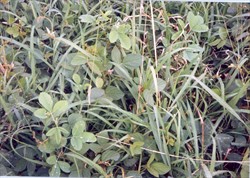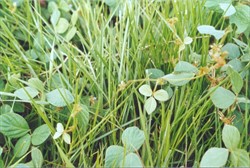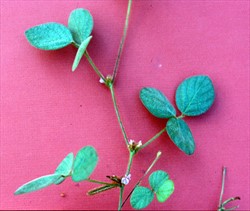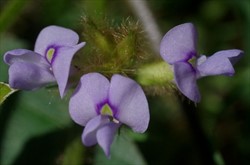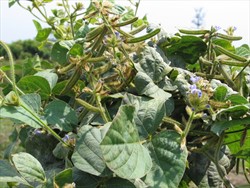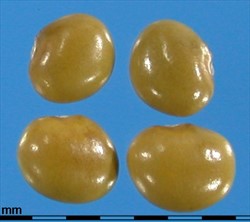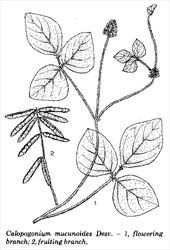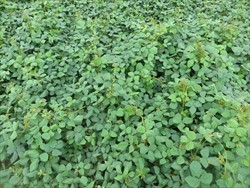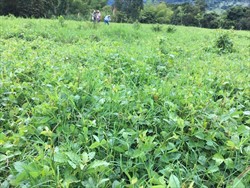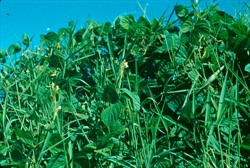Tropical Forages
Family: Fabaceae (alt. Leguminosae) subfamily: Faboideae tribe: Phaseoleae subtribe: Glycininae.
A vigorous, creeping, twining or trailing, short-lived perennial herb, up to several metres long, forming a tangled mass of foliage 30‒50 cm thick, with densely pilose stems with long rust-coloured hairs. Leaves trifoliolate, petiole up to 16 cm long, pilose; leaflets elliptical, ovate or rhomboid ovate, 4‒10 cm × 2‒5 cm, the laterals oblique and adpressed pilose or pubescent on both surfaces. Inflorescence a slender rust-coloured, pseudo- raceme, to 10 cm long, covered with short, dense hairs; blue to purple flowers in fascicles of 2‒6; bell-shaped calyx with five unequal lobes; standard about 1 cm long, emarginate, yellow green centre. Pod linear-oblongoid, 2‒4 cm × 3.5‒5 mm, straight or curved, softly pilose with coarse reddish-brown hairs, impressed between the seeds. Seeds 3–8 per pod, compressed squarish, 2–3 mm long, yellowish or reddish-brown. 50,000–100,000 seeds/kg.
Similar species
C. mucunoides: Stems, petioles, calyces and pods sparsely long-hispid, the trichomes to c. 2 mm long; inflorescences <15 cm long; pods 2–4 cm long, 3.5‒5mm wide.
C. caeruleum: Stems, petioles, calyces and pods densely reddish-brown tomentose, the trichomes not individually visible, inflorescences usually >20 cm long; pods 4–8 cm long, 8 mm wide.
Asia: 毛蔓豆 mao man dou (China); kacang asu, kalopogonium (Indonesia); karaparapak sara naw, santing (Philippines); 擬大豆(Taiwan); thua karopo, thua-khalapo (Thailand)
English: calopo; wild ground nut (USA)
Latin America: calapo, calopo, calopogônio, calopogônio-indico, enxada verde, falso-moromoró, falso ouro, feijão sagu, jequitirana, marmelada de boi, mielillo, orelha de onça (Brazil); bejuco, bejuco culebra, bejuco peludo, bejuquillo de banco, calopo, calopogonium, falso-oró, fríjol velludo, frisolilla, frisolito, galopo, guisante azul, guisante violeta, jequitirana, jequirana, jicama, jiquitirana, napta, pica-pica manso, rabo de iguana (Spanish)
Native:
Northern America: Mexico (Chiapas, Colima, Guerrero, Jalisco, Mexico, Nayarit, Sinaloa, Veracruz)
Caribbean: Cuba, Guadeloupe, Hispaniola, Jamaica, Martinique, Montserrat, Puerto Rico, St. Lucia, St. Vincent and Grenadines
Central America: Belize, Costa Rica, El Salvador, Guatemala, Honduras, Nicaragua, Panama
South America: Colombia, Ecuador, French Guiana, Guyana, Peru, Suriname, Venezuela
Cultivated/naturalized:
Throughout the humid tropics
Forage
Recognised as a valuable pioneer species, reducing erosion and improving soil fertility. Despite generally low palatability, cattle graze calopo during the latter part of the dry season in tropical Asia and Africa. One of very few commercially available legumes in Brazil, but used more as a cover crop rather than as forage.
Environment
Mainly used as cover crop in tropical tree plantations over the past 100 years, in SE Asia often in a mix with other legume species; green manure crop providing large amounts of dry matter through leaf fall. It forms a dense cover even under trees protecting the soil from erosion, improving soil fertility, and smothering weeds, thereby reducing the need for herbicides.
Soil requirements
Grows on a wide range of soil types, but prefers clay soils with pH 4.5‒5.0. In tropical America, grows well on acid soils with high Al saturation. Poor tolerance of salinity.
Moisture
Adapted to the hot, wet tropics with annual rainfall exceeding 1,500 mm where individual plants will persist for 2‒3 years. Will grow in drier environments (>1,000 mm) where it behaves as an annual. Poor drought tolerance but plants will regenerate from seed. Adapted to wet soils and tolerant of inundation.
Temperature
Grows best at 32 ºC maximum and 24 ºC minimum daily temperatures, with outer limits of 36 ºC maximum and 18 ºC minimum. Prefers humid-tropical, low elevations but will grow up to altitudes of 2,000 m asl.
Light
Productivity is relatively constant at 60‒00% light transmission. Will grow productively under mature coconut plantations (60‒70% PAR), but is not tolerant of heavy shade. DM yield, root growth and nodulation decrease markedly as light transmission decreases. Less shade tolerant than , puero (Neustanthus phaseoloides) and centro ( Centrosema molle), which are slower to establish but more persistent under shade.
Reproductive development
Flowering is initiated by short days (<12 hours), neutral days (12‒14 hours), and long days (>14 hours), depending on accession. Calopo is self-fertile and seeds freely. Acts as an annual in seasonally dry environments.
Defoliation
It is not tolerant of frequent severe defoliation but can be cut at intervals of 2‒3 months. Recovers slowly from defoliation. In grazing systems, best results are achieved with rotational grazing at 8‒12 week intervals.
Fire
Will not tolerate fire. However, can regenerate from seed.
Guidelines for establishment and management of sown forages.
Establishment
Has a high proportion of hard seed that requires scarification by mechanical abrasion, soaking in concentrated sulphuric acid for 30 minutes, or hot water treatment (3 minutes at 75 ºC). Normally planted by seed at 1‒3 kg/ha, drilled in rows in new plantations or broadcast in open forages. When broadcast, seed should be spread on the soil surface and then rolled to improve establishment. As a cover crop in tree plantations, planted at 1‒3 kg/ha in species mixtures of 12‒15 kg legume seed. Calopo is promiscuous in its rhizobia requirements, but cowpea inoculant can be used in sterile soils.
Has been established into pangola grass ( Digitaria eriantha) and Paspalum plicatulum in the Northern Territory, Australia, by thoroughly spraying the grass swards with glyphosate (360 g/L) at 10 ml/L and sowing seed on the same day. Can also be established into cultivated strips prepared using disc harrows. Established well when broadcast into upland rice following the final weeding. Mid-season plantings may reduce rice yields.
Fertilizer
On acid soils in the Pantanal, Brazil, productivity was improved by the following fertilizer application (kg/ha): 20 P, 20 S, 60 K and 1,000 dolomitic limestone.
Compatibility (with other species)
Will dominate cover crop mixtures during early growth due to its rapid establishment, but is suppressed by shading as other species develop. Commonly reported as a volunteer legume in humid-tropical native forages.
Companion species
Grasses: Excellent compatibility with tall, erect grasses such as Rhodes grass ( Chloris gayana), pangola grass ( Digitaria eriantha) and setaria (Setaria sphacelata), because it is little eaten. However, low palatability can lead to calopo dominance. Sometimes oversown into signal grass (Urochloa decumbens) pastures in Brazil. Has been found to grow well with competitive species such as Cynodon nlemfuensis and Urochloa humidicola on wet soils.
Legumes: As cover crop in tree plantations in southeast Asia, often planted in a species mixture with one or more of the species , Neustanthus phaseoloides, Centrosema molle, and Grona heterocarpa subsp. ovalifolia.
Pests and diseases
Affected by viruses, including cowpea severe mosaic comovirus, geminiviruses and Centrosema mosaic potexvirus, but these rarely significantly impede growth.
Susceptible to the root-knot nematode, Meloidogyne javanica.
Ability to spread
Will spread naturally under favourable conditions.
Weed potential
Can become a localised weed in humid-tropical environments. Has invaded tropical ecosystems in northern Australia and is listed as a weed in the Philippines, Malaysia and Indonesia.
Nutritive value
In vitro digestibility of leaf DM ranges from 58 to 66% depending on the age of regrowth and level of hairiness. High densities of epidermal hairs (34 hairs/mm²) are associated with lower IVDMD. CP content of top growth ranges from 16 to 24%, with lower values for older growth. Reported in vivo DMD of leaf and stem is 58%.
Palatability/acceptability
Generally regarded as being of low to moderate palatability, but considerably more palatable than . Cattle in confinement have refused to consume freshly cut material, eating the legume only if wilted. In other situations, it is consumed after cattle become accustomed to it. However, in the state of Minas Gerais in Brazil, where pastures may naturally contain a significant amount of the legume, grazing cattle have been observed consuming plants without any problems. A 40% increase in intake was achieved by modifying the taste of calopo with monosodium glutamate (2% DM fed) and molasses (5%), or with sodium hydroxide (4%).
Toxicity
No toxic factors found so far.
Feedipedia link
Dry matter
Under regular cutting, annual yields of 4‒6 t/ha are achieved when cut every 9‒12 weeks. DM yields generally decline over time with repeated cutting or grazing, and yields may be substantially lower in the second and third years after planting. Wet season yield of 3.3 t/ha was recorded for a Urochloa decumbens- pasture in Brazil, compared with 3.0 t/ha for a pure U. decumbens pasture. In Planaltina, Central Brazil, DM yields ranged from 2 to 8 t/ha in the first year of growth, and was highest for late-flowering varieties. When used as an improved fallow, increased maize yield by about 20%, compared with a weed fallow. In association with Urochloa decumbens in Brazil, calopo contributed 416 kg N/ha over 2 years.
Animal production
In Brazil, cattle grazing signal grass (Urochloa decumbens) and U. brizantha pastures at 3.1 head/ha gained 350 g/head/day over a 3 year period, whereas grass pastures oversown with gained 400 g/head/day over the same period. The legume percentage decreased linearly from the 1st to the 3rd year.
2n = (24), 36. There are no breeding programmes for calopo. A large germplasm collection with significant variation in DM production, dry season leaf retention, nutritive value (IVDMD) and seed yield is available at CIAT.
Produces high yields of seed. In a Brazilian savanna environment, pure seed yields ranged from 118 to 860 kg/ha, with early-flowering accessions being higher yielding than late-flowering accessions. Elsewhere, yields of 200‒300 kg/ha have been recorded. Seed may sprout in the pod in wet conditions.
No specific information available.
- Establishes rapidly from seed to provide early ground cover.
- Useful cover crop or pioneer legume.
- Wide edaphic adaptation including wet soils.
- Relatively low palatability to ruminants.
- Intolerant of heavy grazing or regular cutting.
- Poor tolerance of heavy shade.
- Weed potential.
Carvalho-Okano, R.M. de and Leitão Filho, H.F. (1985) Revisão taxonômica do gênero Calopogonium Desv. (Leguminosae - Lotoideae) no Brasil. Revista Brasileira de Botânica 8:31–45.
Chen, C.P. and Aminah, A. (1992) Calopogonium mucunoides. In: Mannetje, L.’t and Jones, R.M. (eds) Plant Resources of South-East Asia No. 4. Forages. Pudoc Scientific Publishers, Wageningen, the Netherlands. p. 72–74. edepot.wur.nl/327785
McSweeney, C.S. and Wesley-Smith, R.N. (1986) Factors affecting the intake by sheep of the tropical legume, Calopogonium mucunoides. Australian Journal of Experimental Agriculture 26:659–664. doi.org/10.1071/EA9860659
Pizarro, E.A. and Carvalho, M.A. (1997) Evaluation of a collection of Calopogonium mucunoides Desv. for the Cerrado ecosystem, Brazil. Journal of Applied Seed Production 15:17–21. bit.ly/3bv1qeS
Seiffert, N.F. and Zimmer, A.H. (1988) Contribución de Calopogonium mucunoides al contenido de nitrógeno en pasturas de Brachiaria decumbens. Pasturas Tropicales 10(3):8–13. bit.ly/39peBfX
Veasey, E.A., Werner, J.C., Colozza, M.T., Freitas, J.C.T. de, Lucena, M.A.C. de, Beisman, D.A. and Gerdes, L. (1999) Avaliação de caracteres morfológicos e agronômicos em leguminosas forrageiras tropicais visando a produção de sementes. Boletim de Indústria Animal 56(2):109–125. iz.sp.gov.br/bia/index.php/bia/article/view/909
CIAT 822, CIAT 20709 Evaluated at Planaltina, Central Brazil. Superior dry season leaf retention.
NO 1194, NO 1257, NO 1715, NO 1824 Evaluated at Nova Odessa, São Paulo state, Brazil. Superior seed production, vegetative growth and tolerance of pests and diseases.
